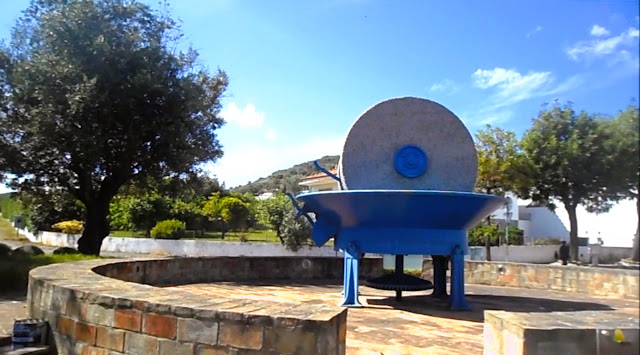SANTA CATARINA DA FONTE DO BISPO
37° 09' 12" N; 7° 47' 18" W
Santa Catarina da Fonte do Bispo is a Portuguese parish in the municipality of Tavira, with an area of 118.98 km² and 1873 inhabitants (2021 census). Its population density is 15.7 inhabitants/km², which allows it to be classified as a Low Density Area
The main sites in this parish are:
Águas de Tábuas, Alcaria do Cume, Alcaria Fria, Alcarias, Alcorvel, Alquirinhos, Amarela, Amendoeira, Aporfiosa, Barrocais, Bengado, Boavista, Carrasqueira, Carvalhal, Carvalhosos, Casas Altas, Casas Juntas, Casas Juntas, Casas Novas, Cerro do Leiria, Corte, Corte das Noivas, Corte do Peso, Corte Vidreiros, Cruzes, Curral da Pedra, Joliricopico, Desbarato, Eiras Altas, Espartosa, Fonte do Bispo, Funchal, Hortas, Juliãos, Laranjeiras, Larangeiro, Malhada de Álvaro Vaz, Malhada do Judeu, Malhada do Nobre, Malhada do Rico, Marco, Montes e Lagares, Morenos, Pocilgais, Torre, Umbria, Várzeas and Várzeas de Vinagre.
History
Santa Catarina lies midway between the important Roman port town of Santa Luzia da Tavira (named Balsa in Roman times) and the Roman settlement of Sao Bras de Alportel.
The oldest record from this region, the Cartório Notarial de Tavira (of 10 April 1601) identified the organized settlement of Santa Catarina. The church was erected sometime in the 15th century and complements the style of the parochial church of the Misericórida in Tavira, which itself was built at the end of the first half of that century. It is assumed that the parish was established some time prior to the erection of the church. The oldest ecclesiastical records, the births, baptisms, marriages and deaths recorded from this parish correspond to evidence from the Torre do Tombo, and situated the parish around 1632.
Fonte do Bispo was a toponymic name referenced as early as the 14th century. The parish was named after Saint Catherine of Alexandria, who perished in 307 AD, referring to a legend stating that an image of Catherine appeared at the fountain of the bishop (Portuguese: Fonte do Bispo): this gave rise to the region's name.
Economy
The main economic activities of this parish are the production of olive oil, the ceramics industry (manufacture of tiles, tiles and bricks), rural tourism and distilleries (mainly medronho brandy)
The conversion of the into a digital arts center is planned for 2026.
Geography
Santa Catarina is a small agglomeration of homes, situated on the edge of the Tavira-Loulé roadway (the Estrada Nacional E.N. 270), approximately 11 kilometers (6.8 mi) from the urban center of Tavira. The famous Fonte do Bispo is located some distance from this road, along the rocky cliffs.
The parish is intimately associated with the region's soils. The southern part of the parish, south of EN 270, is based in limestone, characterized by superficial deposits that extend from the sub-soils. To the north, and parallel to the limestone areas, is a narrow strip of red sandstone, known as the grés de Silves, locally referred to as arneiro or pedra amoladeira. To the north of this zone is a mountainous schist zone, with heavily carved valleys and rounded ridges.
The limestone formation is named the Barrocal, and is occupied by orchards, olive trees, almond trees, figs and vineyards, in addition to the cultivation of cereal crops and legumes. The red sandstone grés de Silves has also been used by locals for planting orchards, irrigated by rainwater collected from the slopes of the ridges. The ridge, including areas of the Barrocal and Arneiro, are alluvial zones; the mountains around these areas produce wheat, barley, vineyards and olive orchards.
The Barrocal and Arneiro are zones of dispersed settlements, homes isolated from one another, while in the mountain regions, the land is broken by more dense groupings of settlements. Consequently, a toponymic reference to sites (Portuguese: sítios) and mountain (Portuguese: montes) settlements prevails. A sítio is a determined area of the territory with dispersed habitat, while the montes is a mountain-top locality, independent of the number of dwellings, but relying on its influence.
Local Festivals and Events
August 3rd. Saturday & Sunday - Vigil of Our Lady of Sorrows Catholics are invited to contemplate the seven sorrows of the Blessed Virgin Mary.
August 25 - Santa Catarina Fair - in 1813, the Santacatarinenses asked the Príncipe Regente for authorization to hold an annual fair in order, with the income of the respective territory, to increase the celebration that they already offered to Nossa Senhora das Dores (Our Lady of Sorrows). It is held over 4 days around the 25th. of the month.
November 11 - Saint Martin's Day - marks the arrival of winter, associated with men, the celebration of the maturation of the new wine, and roasted horse chestnuts. It is celebrated traditionally around a bonfire, and drinking a local light alcoholic beverage called água-pé, or the stronger jeropiga.
November 25 - Saint Catherine's Day - also marks the arrival of winter, associated with women.
On the following Sunday, a church procession around the village takes place in the afternoon.
Market Day - 4th. Sunday of every month.
Climate
Santa Catarina da Fonte do Bispo has a hot-summer Mediterranean climate with hot, dry summers and mild, wet winters. Its location lies between the Algarvian Barrocal, an inland, higher altitude karstic region, and Serra towards the coast, making its winters slightly cooler and summers hotter than those experienced on the coast. Precipitation is also higher, with December being the wettest month.
💓💓💓💓💓
SEARCH IN ALPHABETICAL ORDER
IN THE DISTRICT OF FARO
💓💓💓💓💓
Return to mainland Portugal &
the Azores and Madeira islands
















